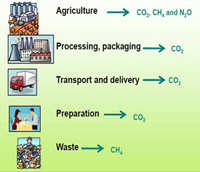by Bonny Bentzin, Director – University Sustainability Practices, Global Institute of Sustainability, Arizona State University
(This article appears in the April, 2010 issue of The ACUPCC Implementer)
In today’s sustainability conscious world, there has been much discussion about food waste reduction options. At Arizona State University (ASU), in conjunction with our Carbon Neutrality goal, we have established a goal for Zero Waste (solid waste and water waste). Our food waste reduction strategy includes harvesting food from our landscaping, diverting food waste through appropriate donations, implementing trayless dining programs, monitoring consumption patterns and tracking orders, and the exploration of composting programs. Some of these options are proving more complex than others.

"Harvesting oranges from ASU's Tempe Campus Arboretum". Photo: Vince Palermo, Global Institute of Sustainability, ASU


 Peter Bardaglio
Peter Bardaglio


 Earlier this month, I traveled to Nashville, TN, where I attended the
Earlier this month, I traveled to Nashville, TN, where I attended the 